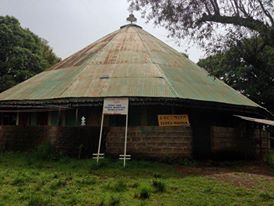By Laura Binkley, student
Ohio State College of Public Health and
School of Environment and Natural Resources
During a quick visit to Bahar Dar, we were able to venture into Lake Tana. Lake Tana is the widest lake in Ethiopia and one of the largest lakes in all of Africa. Emptying into the Nile River, it contains several islands. Many of these islands possess ancient monasteries that have been well preserved by the monks. We decided to take a boat tour that would take us out to one of the islands.
Traveling across the lake provided us with fascinating views of the landscape and a strong sense of calm after an intense week of data collection. As we moved through the lake we passed giant pelicans, townspeople cleaning their clothes in the lake, and fisherman fishing in hand-made papyrus boats that seemed impossible to balance in. On our way to the island we crossed paths with the Nile River itself which was a pretty incredible experience.
When we stepped off of the boat onto the island we were surrounded by green. A vast field included papyrus plants and a variety of trees and plants from coffee to mango and banana. We walked down a small mud path towards the monastery where we were greeted by villagers selling fresh fruits and tiny handmade papyrus boat souvenirs among other things.
Once we arrived at the monastery we paid our fee to enter and were then led by an elderly monk to a small stand that he called a museum. He explained that the monastery had been around since the 12th century and then proceeded to show us the contents of the museum which consisted of ancient books, an emperor’s robe, elaborate crosses, and other priceless valuables of the church.
Once our tour of the museum stand was complete the monk lead us to the monastery itself. The monasteries on all of the islands are circular in shape with three main parts. We started at the outer part which consisted of a small wall left open to the outside that surrounded the monastery. Here was where we were to take off our shoes before entering the sacred place.
We were then lead inside to the second part. This section was dark except for the little light that illuminated the walls which were covered in beautiful Christian art pieces. There were also ancient worship drums that were made of clay and covered in hide. We were not allowed to enter the third section where a sacred arc in honor of Mary was hidden. I can only imagine how fascinating it must look.
Once we had a chance to look around for a bit we grabbed our shoes and exited the monastery. We thanked the monk and then headed back down the trail to the boat that had been waiting for us. The boat then headed back towards the mainland again. It was all a very surreal experience that can only be found here in Ethiopia.
